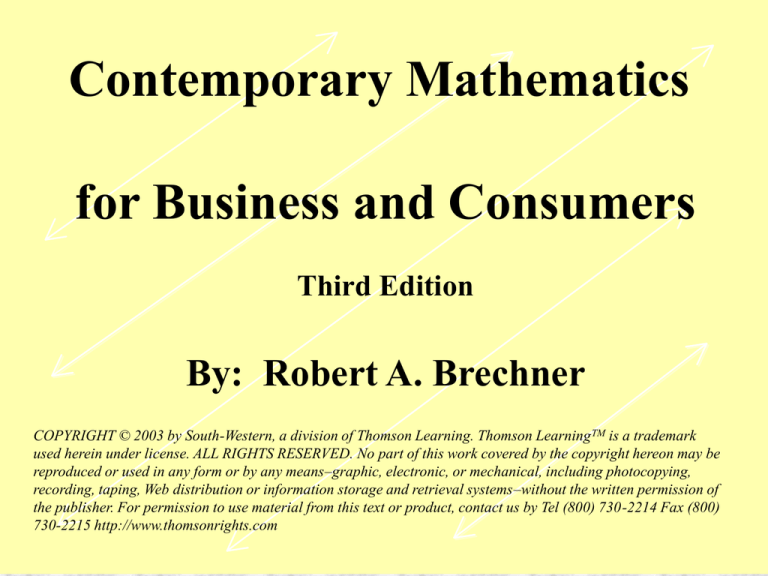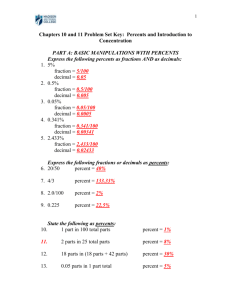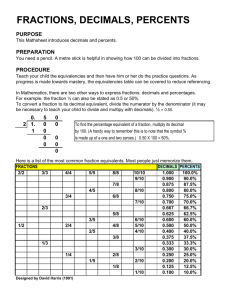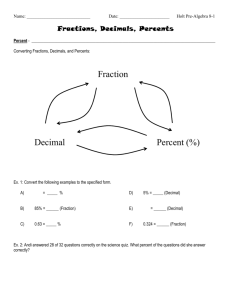
Contemporary Mathematics
for Business and Consumers
Third Edition
By: Robert A. Brechner
COPYRIGHT © 2003 by South-Western, a division of Thomson Learning. Thomson Learning TM is a trademark
used herein under license. ALL RIGHTS RESERVED. No part of this work covered by the copyright hereon may be
reproduced or used in any form or by any means–graphic, electronic, or mechanical, including photocopying,
recording, taping, Web distribution or information storage and retrieval systems–without the written permission of
the publisher. For permission to use material from this text or product, contact us by Tel (800) 730-2214 Fax (800)
730-2215 http://www.thomsonrights.com
Chapter 6
Percents and their Applications in Business
Copyright © 2003 by South-Western
Chapter 6, Percents and Their Applications in
Business
Section I: Understanding and Converting Percents
6-1 Converting percents to decimals and decimals to
percents.
6-2 Converting percents to fractions and fractions to
percents.
Section II: Using the Percentage Formula to Solve
Business Problems
6-3 Solving for the portion.
6-4 Solving for the rate.
6-5 Solving for the base.
6-6 Determining rate of increase or decrease.
Chapter 6, Percents and Their Applications
in Business (Cont.)
• Section III: Solving Other Business Problems
Involving Percents
6-6 Determining rate of increase or decrease.
6-7 Determining amounts in increase or decrease
situations.
6-8 Understanding and solving problems involving
percentage points.
Section I, Understanding and Converting
Percents
6-1 Converting Percents to Decimals and Decimals to
Percents
Steps for Converting percent to a decimal:
Step 1. Remove the percent sign
Step 2. Divide by 100.
Step 3. If the percent is a fraction, such as 3/8%, or a mixed number,
such as 4 3/4%, first change the fraction to a decimal, then follow
Steps 1 and 2 above.
Step 4. If the percent is a fraction such sa 2/3%, which converts to
repeating decimal, .66666, round the decimal to hundredths, .67, then
follow Steps 1 and 2 above.
2/3 % = .67 % = .0067
EVERYBODY’S BUSINESS
To divide a number by 100, move the decimal
point two places to the left. Add zeros as
needed.
Remember, if there is no decimal point, it is
understood to be to the right of the digit in the
ones place.
(24 = 24.)
Steps for Converting A Decimal or Whole
Number to a Percent
Step 1. Multiply by 100.
Step 2. Add a percent to the number.
Step 3. If there are fractions involved, such as ¾, convert
them to decimals first, then proceed with Steps 1 and
2 above.
¾ = .75 = 75%
6-2 Converting a Percent to A Fraction
Steps for Converting a Percent to a Fraction:
Step 1 Remove the percent sign.
Step 2. (If the percent is a whole number)Write a fraction with the
percent as the numerator and 100 as the denominator, If that fraction is
improper, change it to a mixed number. Reduce to lowest terms.
or
Step 2. (If the percent is a fraction)Multiply the number by 1/100 and
reduce to lowest terms.
or
Step 2. (If the percent is a decimal) Convert it to a fraction and
multiply by 1/100. Reduce to lowest terms.
Steps for Converting Fractions or Mixed
Numbers to Percents
Step 1. Change the fraction to a decimal by dividing
the numerator by the denominator.
Step 2. Multiply by 100. (Move the decimal point
two places to the right. Add zeros as needed.)
Step 3. Write a percent sign after the number.
Section II, Using the Percentage formula to
Solve Business Problems
Steps of Solving Percentages Problems
Step 1. Identify the two knowns and the one unknown.
Step 2. Choose the formula that solves for that unknown.
Step 3. Solve the equation by substituting the known
values for the letters in the formula.
EVERYBODY’S BUSINESS
SHORTCUT
Remember to use the % key on your calculator.
12
400
%
X
48
=
Section III, Solving Other Business
Problems Involving Percents
6-6 Determining Rate of Increase or Decrease
Step 1. Identify the original and the new amounts, and
find the difference between them.
Step 2. Using the rate formula, R = P divided by B,
substitute the difference from Step 1 for the portion, and
the original amount for the base.
Step 3. Solve the equation for R. Remember, you answer
will be in decimal form, which must be converted to a
percent.
6-7 Determining Amounts in Increase of
Decrease Situations
Steps for Determining the new Amount After a
Percentage Change:
Step 1. In the formula Portion = rate X Base, substitute
the original amount, or starting point, for the base.
Step 2a. If the rate of change is an increase, add that rate
to 100% to determine the rate.
Step 2b. If the rate of change is a decrease, subtract that
rate form 100% to determine the rate.
Step 4. Solve the equation for the portion.
EVERYBODY’S BUSINESS
Remember, if the rate of change is increase, add
that rate to 100%.
If that rate of change is a decrease, subtract that
rate from 100%.
Steps for Determining the Original amount
before a percentage Change:
Step 1. In the formula Base = Portion divided by rate,
substitute the new amount for the portion.
Step 2a. If the rate of change is an increase, add that rate to
100% to determine the rate.
Step 2b. If the rate of change is a decrease, subtract that rate
from 100% to determine the rate.
Step 3. Solve the equation for the base.
EVERYBODY’S BUSINESS
Calculating percentage points is an application of
the rate formula, Rate = Portion divided by
Base, with the change in percentage points as
the portion and original percentage points as
the base.
Chapter 6
Portion = Rate x Base
Rate = Portion Base
Base = Portion Rate
Copyright © 2003 by South-Western






